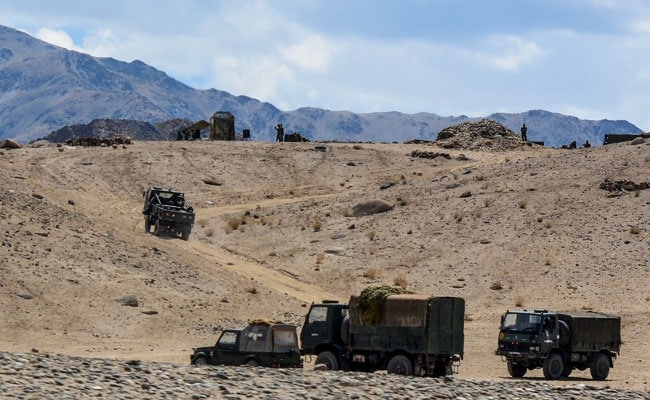India and China are like ‘yin’ and ‘yang’. One passive, eternally content with whatever it has. The other is hyperactive, always seeking more, often through power and deception. But unlike the traditional yin and yang that bring order in the otherwise chaotic world, India and China find themselves stuck in a face-off mode with their massive armies standing too close for comfort. Primarily because the Dragon refuses to curb its ever-growing appetite for power, territory and resources.
Today, as China is ready with another trick up its sleeve to deceive India in the name of the new Land Border Law, one wonders how far we are going to let the Dragon dictate terms. When are we going to act, rather than react to what Emperor Xi Jinping and his wily comrades/commanders are doing? China is a past master in this game of deception. In a cricketing analogy, it will keep coming out of the crease into the Indian side of the LAC (Line of Actual Control) till it is certain of not getting a bouncer. India, all these years, has been content playing by the rules set by the Dragon.
But why are we abiding by the rules set by our adversary? Because we don’t know the enemy yet. In fact, worse, we even don’t really know who we are. It’s this cocktail of grand ignorance and gross indifference that has mostly created the mess India is in today.
So, who is the Dragon? And why it never says never to a neighbour’s territory which it believes it can annex, intrude into, or at least lay claims at? Because, historically, that has been the nature of the Dragon! Traditional China was just a third of the area it is today. It became what it is through the combination of long-term planning, deception and force. Han China has nothing in common with Xinjiang, Tibet and Inner Mongolia, still have we ever questioned its presence in these territories?
In 1965, historian RC Majumdar, while highlighting China's inherent imperialist nature, wrote: “Thanks to the systematic recording of historical facts by the Chinese themselves, an almost unique achievement in oriental countries… we are in a position to follow the imperial and aggressive policy of China from the third century BC to the present day, a period of more than 2,200 years… It is characteristic of China that if a region once acknowledged her nominal suzerainty even for a short period, she would regard it as a part of her empire forever and would automatically revive her claim over it even after a thousand years whenever there was a chance of enforcing it.”
Sadly, for India, scholars like Majumdar were cornered in the late 1960s when under the stewardship of Nurul Hasan, a new set of Marxist historians led by Romila Thapar, Bipan Chandra and RS Sharma was allowed to hijack the country’s mindscape. For these intellectuals, the erstwhile Soviet Union was the “Only Fatherland”, and China nothing short of Medina, if not Mecca itself! Is it any surprise that year after year hardly any book of consequence on China, its true imperialist character appeared on the Indian horizon?
But why just blame the intellectuals when the political leadership obdurately refused to look at China dispassionately. Even six months after Mao Zedong openly reiterated his determination to ‘liberate’ Tibet, then Prime Minister Jawaharlal Nehru maintained that the Chinese invasion of Tibet was not likely. On 9 July 1949, he wrote a note to the Secretary General, Ministry of External Affairs: “Whatever may be the ultimate fate of Tibet in relation to China, I think there is practically no chance of any military danger to India arising from any possible change in Tibet. Geographically, this is very difficult and practically it would be a foolish adventure. If India is to be influenced or an attempt made to bring pressure on it, Tibet is not the route for it.”
Mao’s troops invaded Tibet in 1950. Nehru himself conceded the mistake to C Rajagopalachari more than a decade later. Soon after the disastrous 1962 war, he said: “Morally I find it hard to say that the Chinese government had deliberately deceived us at any stage. We may have deceived ourselves…”
India under Nehru just refused to look at the writing on the wall. This explains why even when the then Army Chief, KS Thimayya, raised doubts over Chinese intentions, our political leadership ensured that India’s ordnance factories, as revealed by TJS George in his biography of then Defence Minister VK Krishna Menon, were busy making hair-clips and pressure cookers and preparing to make mechanical toys! The Chinese didn’t stab from the back; it was “a stab from the front”, as MJ Akbar asserts in his Nehru biography.
The Chinese, to their credit, never hide their true intentions. In fact, they reiterated them again and again. Arun Shourie gives a fascinating perspective about this Chinese way of functioning. He writes in his book, Self-Deception: India’s China Policies, “Make no mistake: China watches… the feeble, confused, contradictory ways in which our governments, and even more our society reacts each time it advances a claim. And it pursues its policy: Claim; repeat the claim; go on repeating the claim; grab; hold; let time pass. And they will reconcile themselves to the new situation. Has the policy not succeeded in regard to Tibet?”
But it’s not that the Dragon just screams. It also knows when to keep quiet. Shyam Saran, former Foreign Secretary and one of the best minds on China in current times, narrated a story during a public lecture in 2012. Referring to a conversation between former Secretary-General, Ministry of External Affairs, RK Nehru, and Chinese Premier Chou En-lai in 1962, just before the big war, Saran said, “RK Nehru drew attention to reports that China was leaning towards the Pakistani position that Jammu & Kashmir was a disputed territory. He recalled to Chou an earlier conversation, where when asked whether China accepted Indian sovereignty over J&K, he had said rhetorically — has China ever said that it does not accept Indian sovereignty over J&K, or words to that effect. At this latest encounter, Chou turned the same formulation on its head, to ask: Has China ever said that India has sovereignty over J&K?”
What complicated the matter for India is its disproportionate contentment with the resources, territories it has. This goes to the extent that when an enemy country grabs a portion of India’s territory, our leadership justifies the enemy act with a ‘not-even-a-blade-of-grass-grows-there’ statement. Many a times this is compounded by a colossal lack of awareness about India’s past and its legitimate historical rights and claims.
Historically and civilisationally, India’s claims over Tibet and Xinjiang are far greater and credible than China’s. To give an example, in the 4th century CE lived Sanskrit scholar Kumarajiva, born to a Kashmiri father and a Kuchean mother. His story is a stark reminder that India didn’t shrink in 1947 alone; this has been a constant phenomenon for the last 2,000 years. For those not well versed with India’s past, Kucha, in northern Tarim basin, exists in the present-day Xinjiang. A centre of Buddhist learning, it was from here that Indian music had spread to China. It needs to be mentioned that Yarkand and Khotan (which tradition says was built by King Ashoka’s son Kutsan) in northern Tarim valley were centres of Mahayana Buddhism, while Kashgar, Kucha and Turfan were the hubs of Hinayana Buddhism.
One can gauge the civilisational/cultural presence of Hindu/Buddhist India from the fact that Kumarajiva, after learning Buddhist scriptures in Kashmir, also a centre of Shaiva philosophy, studied four Vedas, five sciences, Brahmanical Shastras and astronomy in Kashgar — it’s the same territory that China today claims to be historically the part of the great Chinese civilisation!
So, what does the Kumarajiva story tell? That India has a greater civilisational/historical claim over Xinjiang and Tibet than China. But what did India do? Far from making any claims or at least questioning Chinese designs, it helped Beijing control these territories. This included rejecting moves in the UN to discuss Tibet and a US call in 1960 for Tibetan ‘self-determination’. Nehru, in 1959-60, went to the extent of discouraging Tibetan authorities from approaching the UN, but when they did, India abstained from the vote. China returned the compliments by first siding with Pakistan in questioning India’s Kashmir policy and then launching a full-fledged war in 1962. The rest, as they say, is history.
Today, six decades later, as the militaries of India and China are stuck in a standoff-like situation for more than a year at the LAC in eastern Ladakh, one needs to ask: How long will India take to put in place a proper China policy? To the credit of the Modi government, it can at least be said to be moving in the right direction. But still, it’s far from being a consolidated and coordinated approach aimed at hurting the Dragon and its interests.
To begin with, India should start questioning the Chinese forcible occupation of Tibet, Xinjiang and Inner Mongolia, and most importantly, give Taiwan a diplomatic high-five. An inherently imperialist China obsessed with territories just can’t afford to see two-thirds of its territories painted not in red. This would set the tone for our future diplomatic endeavours.
Once the Dragon knows that it would get as hard as it gives, it might be tempted to act responsibly. Till now, it has not even been encouraged to be reasonable. Being a bully has worked to its advantage. But not this time! New India has finally acted. It has called Beijing’s bluff at the LAC, but it’s a work in progress. Chinese are watching us closely on how far we can go. And we should go as far as they have gone. At least! So, if they find Kashmir and Arunachal Pradesh disputed territories, so should be Tibet and Xinjiang (anyway, our historic, civilisational ties with these two places go much deeper than China’s). And if Emperor Xi thinks he can raise a toast with Taliban Khan, then we shouldn’t mind having a sumptuous dinner with our Taiwanese friends either!
Link
Time has come for India to start questioning China’s forcible occupation of Tibet, Xinjiang and Inner Mongolia, and most importantly, give Taiwan a diplomatic high-five.

www.firstpost.com

 www.ndtv.com
www.ndtv.com











